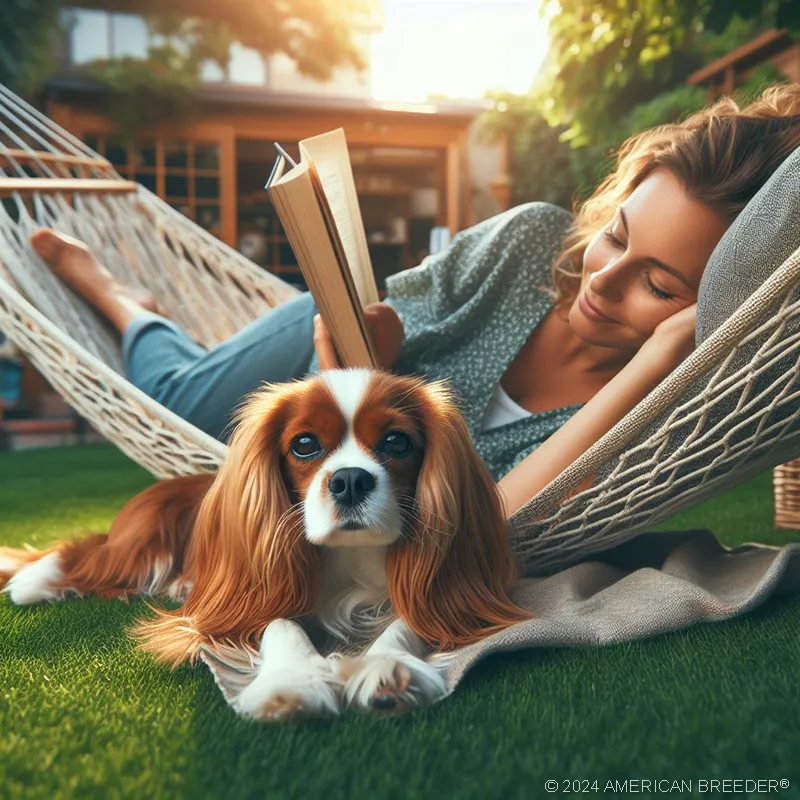Bonding with Royalty: Your Complete English Toy Spaniel Guidebook
Introduction
 Welcome to the world of the English Toy Spaniel Dog, a breed known for its elegance, charm, and companionship. As you embark on this journey, prepare to uncover the captivating history, unique traits, and unwavering devotion that make the English Toy Spaniel a beloved canine companion. The English Toy Spaniel Dog, often referred to as the "Charlies," captures hearts with their expressive eyes, silky coat, and endearing personality. This breed embodies the perfect blend of regal beauty and affectionate nature. Their dainty size and graceful demeanor make them a cherished lap dog, delighting in cuddles and quiet moments with their human companions.
Welcome to the world of the English Toy Spaniel Dog, a breed known for its elegance, charm, and companionship. As you embark on this journey, prepare to uncover the captivating history, unique traits, and unwavering devotion that make the English Toy Spaniel a beloved canine companion. The English Toy Spaniel Dog, often referred to as the "Charlies," captures hearts with their expressive eyes, silky coat, and endearing personality. This breed embodies the perfect blend of regal beauty and affectionate nature. Their dainty size and graceful demeanor make them a cherished lap dog, delighting in cuddles and quiet moments with their human companions.
Considerations Before Choosing
While the allure of the English Toy Spaniel's charm is undeniable, potential owners should consider their commitment to providing consistent care, companionship, and a nurturing environment. As a breed with a strong attachment to their families, English Toy Spaniels thrive in homes where they are embraced as integral members of the household.
Breed Background and History
Origin and Development
The history of the English Toy Spaniel Dog is interwoven with royal courts and aristocracy. Tracing its roots back to Asian toy breeds that were introduced to European nobility, the English Toy Spaniel became a favorite among monarchs. These dogs adorned the laps of kings and queens, making them symbols of refinement and luxury.
Historical Significance or Cultural Relevance
English Toy Spaniels were esteemed companions during the Tudor and Stuart eras, often depicted in the artwork of renowned painters. They graced the laps of kings like Charles II, giving rise to the breed's endearing nickname, "King Charles Spaniel." The breed's popularity transcended generations and cultures, remaining an enduring symbol of companionship and loyalty.
 Purpose or Original Use
Purpose or Original Use
Originally bred for companionship, the English Toy Spaniel Dog's primary purpose has always been to provide affection, comfort, and joy to their owners. While they may have shared hunting lineage with larger spaniel breeds, their small size and gentle disposition steered them away from the field and into the hearts of those seeking an adoring companion.
Appearance
Size, Weight, and Physical Appearance
The English Toy Spaniel Dog is characterized by its compact size, typically weighing around 8 to 14 pounds and standing 9 to 10 inches tall at the shoulder. Their well-proportioned body showcases elegant curves, with a level topline and a gentle arch over the loin.
Coat Type, Color Variations, and Patterns
The breed's luxurious coat comes in four distinct color variations, each affectionately named after royals: Blenheim (chestnut and white), Tricolor (black, white, and tan), Ruby (solid red), and Prince Charles (black and tan). The silky, medium-length coat is complemented by feathering on the ears, chest, legs, and tail, adding to their regal appearance.
Distinctive Features or Markings
The English Toy Spaniel's large, expressive eyes are one of its most captivating features. Framed by a slightly rounded skull and well-set ears, these eyes radiate warmth and affection. Their short, slightly upturned nose gives them an endearing look, while their compact, square muzzle adds to their refined expression.
Temperament and Personality
Typical Temperament Traits and Behavior
Tendencies Gentle and affectionate, the English Toy Spaniel Dog thrives on companionship and strives to please its human family. Known for their loyalty, they form strong bonds with their owners, often becoming intuitive to their moods and needs. Despite their regal appearance, they're approachable and down-to-earth, embracing cuddles and laps with enthusiasm.
Energy Levels and Activity Requirements
While not overly energetic, the English Toy Spaniel still enjoys daily walks and play sessions to keep their minds and bodies engaged. They are content with indoor activities, making them suitable companions for apartment living. However, their connection with their family makes them happiest when included in everyday activities. Compatibility with Different Lifestyles and Family Dynamics
Compatibility with Different Lifestyles and Family Dynamics
This breed's adaptable nature allows them to flourish in various lifestyles, from urban apartments to suburban homes. They make excellent companions for seniors, families with children, and single individuals seeking a loyal friend. Their gentle demeanor also makes them suitable therapy dogs, offering comfort and companionship to those in need.
Trainability and Intelligence
Trainability Level and Ease of Learning
The English Toy Spaniel Dog possesses a moderate level of trainability. While they have a keen desire to please, they may exhibit a touch of stubbornness at times. Consistent, positive reinforcement training methods work best, as these dogs respond well to praise, treats, and affection.
Willingness to Please Their Owner
The breed's deep bond with their owner fuels their willingness to please. Their affectionate nature drives them to learn and follow commands to make their owner happy. They thrive in environments where training is infused with patience, consistency, and gentle guidance.
Intelligence and Problem-Solving Abilities
English Toy Spaniels showcase an inherent intelligence that extends beyond their adorable appearance. While they may not excel in complex tasks like some working breeds, they possess a sharp ability to learn and understand cues. Mental stimulation through interactive toys and puzzle games can further engage their minds and keep them entertained.
Recommended Training Approaches and Techniques
When training an English Toy Spaniel Dog, it's essential to maintain a positive and patient approach. Short, engaging training sessions with rewards like treats and praise can keep them motivated. Incorporating variety into their training routine helps prevent boredom and encourages their active participation.
 Training or Skills Best Suited for English Toy Spaniel Dogs
Training or Skills Best Suited for English Toy Spaniel Dogs
English Toy Spaniels excel in basic obedience training, such as commands like "sit," "stay," and "come." Due to their gentle nature, they are also well-suited for therapy work, where their comforting presence can bring joy to those in hospitals or nursing homes. Engaging them in canine sports like agility or rally obedience can also provide mental and physical stimulation.
Practical Considerations
Size of Sleeping Quarters Depending on Size
While English Toy Spaniels are small in size, they appreciate a cozy, comfortable sleeping area. Providing a soft bed or cushion in a quiet corner of your home ensures they have a peaceful resting spot where they can retreat and recharge.
Daily Exercise Needs and Requirements
Though they don't have high energy levels, daily exercise remains crucial to the English Toy Spaniel Dog's overall well-being. Regular walks, interactive play sessions, and mental enrichment activities help prevent obesity and keep their minds sharp.
Level of Playfulness
Their playful nature shines through during interactive play sessions. Engaging in games like fetch, hide-and-seek, and puzzle toys allows them to release their playful energy while bonding with their family.
Level of Intelligence
The English Toy Spaniel's intelligence is characterized by their ability to understand and learn commands relatively quickly. They possess an innate awareness of their surroundings and their owner's emotions, allowing them to adapt and respond accordingly.
Health and Care
 Common Health Issues or Predispositions of English Toy Spaniel Dogs
Common Health Issues or Predispositions of English Toy Spaniel Dogs
As with any breed, English Toy Spaniels may be susceptible to certain health issues, including heart conditions, respiratory concerns due to their brachycephalic (short-nosed) structure, and dental problems. Regular veterinary check-ups and a healthy diet can help mitigate these risks.
Allergies and Specific Dietary Considerations
Some English Toy Spaniels may have sensitivities or allergies, particularly to certain ingredients in dog food. Consulting a veterinarian to determine the most suitable diet can help prevent digestive issues and skin irritations.
Lifespan and Longevity Expectations
On average, the English Toy Spaniel Dog has a lifespan of around 10 to 12 years. Providing proper nutrition, regular exercise, routine veterinary care, and a loving environment can contribute to their overall health and longevity.
Grooming Requirements Based on Coat Type and Size
The breed's medium-length coat requires regular grooming to prevent matting and maintain its luster. Brushing a few times a week helps distribute natural oils and remove loose hair, while trimming feathering around the ears, paws, and tail helps keep them tidy.
Socialization and Compatibility
Interaction with Children, Other Pets, and Strangers
English Toy Spaniels typically get along well with children and other pets when properly socialized from a young age. Supervised introductions and positive experiences foster harmonious relationships and prevent any potential conflicts.
 Socialization Needs and Tips for Proper Socialization
Socialization Needs and Tips for Proper Socialization
Early and ongoing socialization is essential for the English Toy Spaniel Dog's well-rounded development. Exposing them to different environments, people, and situations helps build their confidence and reduces the likelihood of shyness or fearfulness.
Precautions or Considerations for Multi-Dog Households
In multi-dog households, providing individual attention and ensuring each dog has its own space can help prevent any feelings of competition or territorial behavior. Supervised interactions and fair treatment are key to maintaining harmony.
Level of Ease When It Comes to Training English Toy Spaniel Dog
Thanks to their eagerness to please and learn, English Toy Spaniels tend to exhibit a good level of ease when it comes to training. Positive reinforcement methods, patience, and consistency create a positive training experience for both the dog and the owner.
Playtime and Exercise with Other Dogs or Pets
When introduced properly, English Toy Spaniels enjoy playful interactions with other dogs and pets. Monitoring their interactions and encouraging positive play ensures that their social experiences are enjoyable and safe for all involved.
Dog-Friendly Activities and Outings
English Toy Spaniels relish outings that involve human interaction and leisurely strolls. Whether it's a casual walk in the park or a visit to a dog-friendly café, these experiences enhance their bond with their owner and provide mental stimulation.
Living Arrangements and Environment
 Suitability for Different Living Arrangements
Suitability for Different Living Arrangements
The adaptable nature of the English Toy Spaniel Dog makes them suitable for a variety of living arrangements, including apartments, houses, and even rural settings. Their compact size and moderate exercise needs allow them to thrive in various environments.
Space Requirements and Exercise Options
While English Toy Spaniels are content with indoor activities, they still require regular exercise to keep them mentally and physically healthy. Daily walks, play sessions, and access to a secure outdoor area for exploration contribute to their overall well-being.
Climate Considerations and Adaptability
Their small size makes them sensitive to extreme weather conditions. In colder climates, providing them with cozy sweaters or jackets during walks can help them stay warm, while in hotter climates, ensuring they have access to shade and water is essential.
Recommended Yard Size for English Toy Spaniel Dogs
English Toy Spaniels do not require a large yard due to their small size and moderate exercise needs. However, having a secure outdoor space for them to explore and stretch their legs can enhance their quality of life.
Ideal Living Conditions and Environment
Creating a peaceful and comfortable living environment is key to the well-being of the English Toy Spaniel. They thrive in homes where they are treated as cherished family members and have ample opportunities for social interaction, mental stimulation, and physical activity.
Training and Obedience
 Basic Obedience Training and Commands
Basic Obedience Training and Commands
The English Toy Spaniel Dog responds well to basic obedience training, mastering commands like "sit," "stay," "come," and "down." Their eagerness to learn and please their owners makes these training sessions rewarding for both parties.
Advanced Training or Specialized Activities Suited for English Toy Spaniel Dogs
While the English Toy Spaniel may not be suited for high-level competition in activities like agility or advanced obedience, they excel in therapy work. Their gentle nature and small size make them ideal companions for providing comfort to individuals in hospitals, nursing homes, or other therapeutic settings.
Behavioral Challenges or Specific Training
Considerations English Toy Spaniels are generally well-mannered, but like any breed, they may exhibit certain behaviors that require attention. Separation anxiety, for example, can be managed through gradual desensitization training. Their natural tendency to form strong bonds with their owners may result in mild clinginess, which can be addressed by promoting independent activities and gradually increasing periods of separation.
House Training and Potty Training Tips
Consistency and positive reinforcement are key when house training an English Toy Spaniel. Establish a regular schedule for feeding, bathroom breaks, and walks. Reward successful potty behavior with treats and praise, creating a positive association with proper elimination.
Leash Training and Walking Etiquette
Start leash training early to instill good walking habits. English Toy Spaniels should learn to walk calmly on a loose leash without pulling. Reward them for walking at your side and offer treats and praise for positive behavior. Gradually expose them to various environments and distractions to ensure they remain well-behaved during walks.
Exercise and Activity
 Daily Exercise Needs and Recommendations
Daily Exercise Needs and Recommendations
Though not high-energy dogs, English Toy Spaniels benefit from daily exercise to maintain their health and prevent boredom. Aim for around 20 to 30 minutes of moderate exercise through walks, play sessions, and mental enrichment activities.
Mental Stimulation Activities and Games
Engaging their minds is just as important as physical exercise. Puzzle toys, hide-and-seek games, and interactive treat-dispensing toys challenge their problem-solving abilities and keep them mentally sharp.
Exercise Routines and Activity Ideas
Varying their exercise routine with different activities prevents monotony. Rotate between short walks, indoor playtime, and outings to dog-friendly parks. Engage them in activities like hide-and-seek, where they use their keen senses to locate hidden treats or toys.
Energy Outlets for High-Energy Breeds
While not high-energy themselves, English Toy Spaniels can adapt to various energy levels. If you have multiple dogs with differing energy levels, ensure that each dog receives individualized exercise and attention to prevent frustration or tension.
Financial Planning
 Typical Price Range for Purchasing English Toy Spaniels from Reputable Breeders
Typical Price Range for Purchasing English Toy Spaniels from Reputable Breeders
The cost of an English Toy Spaniel Dog from reputable breeders can range from a few hundred to a few thousand dollars. It's important to research breeders thoroughly and prioritize ethical breeding practices to ensure you are bringing home a healthy and well-cared-for puppy.
Initial Costs and Ongoing Expenses
Initial costs include adoption fees or purchase price, vaccinations, spaying/neutering, and microchipping. Ongoing expenses encompass food, grooming, veterinary care, training, toys, and supplies. It's essential to budget for both expected and unexpected costs to provide the best care for your dog.
Considerations for Pet Insurance or Budgeting for Unexpected Medical Costs
Pet insurance can provide financial peace of mind by helping to cover unexpected medical expenses. Alternatively, setting aside a dedicated savings fund for your dog's medical needs ensures that you are prepared to provide necessary care in emergencies.
Options for Pet Care During Vacations
Travel Planning for your English Toy Spaniel's care during vacations or travel is crucial. Options include hiring a trusted pet sitter, utilizing boarding facilities, or seeking out pet-friendly accommodations. Ensuring their comfort and safety while you're away guarantees a stress-free experience for both you and your dog.
Overall Summary
Concise and Cohesive Summary of Key Details
In conclusion, the English Toy Spaniel Dog embodies the perfect blend of elegance and companionship. With their expressive eyes, silky coat, and gentle demeanor, they bring joy to the lives of those fortunate enough to share their homes with them.
 Highlight Interesting and Fun Facts
Highlight Interesting and Fun Facts
Did you know that the English Toy Spaniel was a favorite among European royalty, including King Charles II? Their charming presence and loyal nature have enchanted generations, making them a cherished breed throughout history.
Capture the Breed's Unique Characteristics and Appeal
From their luxurious coat and captivating eyes to their adaptable nature and affectionate personality, the English Toy Spaniel is a breed that truly captures the heart. Their history as royal companions and their ability to provide comfort and companionship make them a remarkable addition to any family.
Emphasize Responsible Ownership
Responsible ownership is paramount for ensuring the well-being of your English Toy Spaniel. From proper training and socialization to regular exercise and veterinary care, your commitment plays a pivotal role in providing a fulfilling life for your furry friend.
Encourage Connection with the Breed Community
Engaging with the English Toy Spaniel community—whether through local clubs, online forums, or social media groups—allows you to share experiences, seek advice, and celebrate the unique qualities of this remarkable breed.
As you embark on your journey with the English Toy Spaniel Dog, remember that every aspect of their history, appearance, temperament, care, and significance contributes to the intricate tapestry that defines this breed. May this comprehensive guide serve as your trusted companion, enriching your understanding and deepening your bond with this elegant and affectionate canine companion.
Conclusion
 Summary of Key Information and Considerations
Summary of Key Information and Considerations
In the grand tapestry of dog breeds, the English Toy Spaniel stands out as a masterpiece—a living embodiment of grace, loyalty, and companionship. From their regal history to their endearing quirks, every facet of this breed tells a story of devotion and connection.
Encouragement to Continue
Learning and Seeking Expert Guidance As you embark on this incredible journey with your English Toy Spaniel, remember that knowledge is a constant companion. Continue to learn, explore, and seek expert guidance to provide the best care and companionship for your furry friend.
Emphasis on Responsible Ownership and Commitment
Owning an English Toy Spaniel is a privilege and a responsibility. Your dedication to their well-being, happiness, and fulfillment will shape the chapters of their life story, ensuring that each page is filled with cherished memories and shared experiences.
In closing, the English Toy Spaniel Dog is not merely a breed; it's a living testament to the remarkable bond that exists between humans and their canine companions. As you embark on this journey together, may your days be filled with wagging tails, heartwarming cuddles, and the timeless joy that comes from sharing your life with a loyal and loving friend?
English Toy Spaniel Dog Quick Reference Guide
Breed Background: Origin: England | Breed Purpose: Companion | AKC Class: Toy | Year Recognized by AKC: 1886 Appearance: Size: Small | Weight: 8-14 pounds | Coat Type: Long, silky | Colors & Patterns: Various colors, often with white markings | Distinctive Features: Short muzzle, large dark eyes, domed head
Appearance: Size: Small | Weight: 8-14 pounds | Coat Type: Long, silky | Colors & Patterns: Various colors, often with white markings | Distinctive Features: Short muzzle, large dark eyes, domed head
Temperament: Energy Level: 2/5 | Loyalty: 5/5 | Friendliness to Pets: 3/5 | Friendliness to Strangers: 3/5 | Trainability: 3/5 | Playfulness: 3/5 | Frequent Barker: 2/5 | Chase Instincts: 2/5 | Sense of Smell: 2/5 | Drive to Hunt: 1/5
Health & Care: Health Issues: Heart conditions, eye problems | Lifespan: 10-12 years | Grooming Difficulty: Moderate | Exercise Needs: Low to Moderate
Socialization: Interaction with Children: Gentle and affectionate | Interaction with Pets: Generally good | Interaction with Strangers: Reserved | Elderly Compatibility: Well-suited | Ease of Training: Moderate
Suitable Living Arrangements: Apartment: Yes | House: Yes | Rural Area: No | Yard Size Requirements: Small yard or daily walks
Training & Obedience: Trainability: 3/5 | Intelligence: 3/5 | Obedience: 3/5 | Problem-Solving: 3/5 | Easily Stimulated: 2/5 | Focus Level: 3/5 | Easily Distracted: 2/5
Financial Planning: Typical Price Range: $800 - $2,500 | Initial Expenses: Puppy essentials, vaccinations | Ongoing Annual Expenses: Food, grooming, vet visits
Breeding: Reproductive Maturity: 8-10 months | Litter Frequency: Once a year | Litter Size: 2-4 puppies | Stud Cost: Varies | Breeding Challenges: Small size can lead to birthing difficulties
Did You Enjoy this Article? Share it and Help Us Spread the Word!
If you found this article helpful, we'd appreciate it if you could share it with your friends or link to it from your website, blog, or group! You can also use the convenient social share tabs on the left side of the screen to instantly share this page to your social media feed. For more ways to support and promote the American Breeder Community, visit our Share & Promote Together page for social media posts and memes you can copy and share. Your support means the world to us!
Disclaimer: The information provided in this article is for general informational purposes only and does not constitute legal, medical, financial, or professional advice. While we strive for accuracy, we make no representations or warranties regarding the completeness, accuracy, reliability, or suitability of the information. Please consult with a professional before making decisions based on the content provided. American Breeder Inc. assumes no responsibility for any errors or omissions or for the results obtained from the use of this information.
